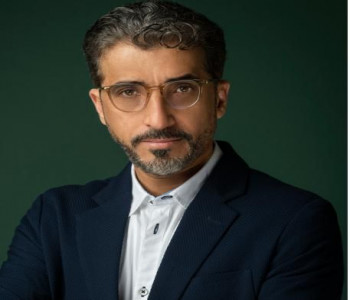Israel's Holocaust museum turns to theatre to engage next generation
Israel's Holocaust museum turns to theatre to engage next generation

By AFP/Ruth Eglash
A desk, paint palette and easel stand in the shadows as the spotlight falls on the actor playing German-Jewish artist Leo Haas, who risked his life to record Holocaust atrocities.
The immersive one-man play in a tiny theatre at Yad Vashem, Jerusalem's Holocaust memorial centre, is part of new initiatives launched ahead of Israel's Holocaust Remembrance Day on Thursday to engage the next generation of visitors.
"The living people who can tell the story are becoming fewer and fewer," said actor Rodie Kozlovsky, getting into character as Haas for a recent show.
Eighty years after World War II, when six million Jews were systematically murdered by the Nazi regime, the number of those who survived is dwindling.
Official estimates show around 220,800 survivors remaining worldwide, but their number is rapidly declining.
Kozlovsky said that bringing to life on stage the accounts of those who survived is an effective way of connecting with more people.
"The theatre has the magic to switch your tempo," he said.
In addition to the theatre, Yad Vashem has also inaugurated a 280-seat outdoor amphitheatre with a state-of-the-art light and sound show that broadcasts across the Valley of Communities, a memorial for some 5,000 European Jewish communities destroyed by the Nazis.
While museum officials hope these formats will help maintain interest in the Holocaust in an era of short attention spans and competing histories, they are also grappling with the fact that such storytelling techniques require artistic liberties.
Clandestine images
Alongside the props used to tell the story of Haas, a Jewish painter and caricaturist who died in 1983, an engineer beams images of his original artworks onto the stage.
His work, on display in the museum, includes replicas of maps and sketches he drew for the Nazis, as well as clandestine images he created to document the starving, desperate inmates of Theresienstadt camp.
The scenery also features an eerie portrait of Adolf Eichmann, one of the main organisers of the Holocaust, his eyes glistening.
Eichmann, the dreaded SS officer captured by Israeli spies in Argentina in 1960 and put on trial in Jerusalem, interrogated Haas after his secret drawings were discovered.
This drawing is the starting point of the play, but Kozlovsky said its rendition is "completely artistic".
"He (Haas) is fighting with himself to forget Eichmann's eyes ... they intimidated him, but he is forced to face the devil once again," he said of the storyline.
Noa Or, associate curator of the artefacts collection in Yad Vashem, said she has struggled with such deviations from pure historical content, but knows it is important as a way to connect to younger visitors.
'New life'
"As curators and historians, it's not easy for us to digest the theatre. We are used to telling the story in a specific way ... but we are learning how to use this instrument in order to get to a wider audience," she said of four original productions currently playing at the theatre.
"On the one hand we want to stay historical and accurate, but on the other hand we want to give the artistic freedom to the producers," Or added, emphasising that she appreciated the fact that "actors are breathing new life into telling these stories".
She said her team scanned Yad Vashem's vast archives of more than 33,000 artefacts, many donated by survivors and their families, to find items that could be brought to life in a play.
Or said the objects were "actually silent witnesses telling the story for many generations to come".
The plays have been translated into English, with an eye to reaching broader audiences worldwide.
Kozlovsky believes telling such stories on stage is more powerful than looking at static artefacts in a museum.
"It's not a show. It's not a spectacle. It's not like somebody started to dance or to sing. It's not going in those directions," he said.
"It's like live testimonies in the voices and the tempos of the people who were here one decade ago and who are now absent."






